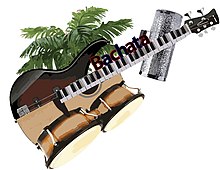
Back باجاتا Arabic Бачата Bashkir Бачата Bulgarian ব্যাচাতা (সঙ্গীত) Bengali/Bangla Bachata Catalan Cerddoriaeth bachata Welsh Bachata (musikgenre) Danish Bachata German Baĉato Esperanto Bachata Spanish
| Bachata | |
|---|---|
 Dominican folk bachata musicians - Amargue Bachata Quintet | |
| Cultural origins | Dominican Republic |
| Subgenres | |
| Regional scenes | |
| Other topics | |
| Music of The Dominican Republic | ||
| General topics | ||
|---|---|---|
| Related articles | ||
| Genres | ||
| Media and performance | ||
|
||
| Nationalistic and patriotic songs | ||
|
||
| Regional music | ||
|
||
| This article is part of a series on the |
| Culture of the Dominican Republic |
|---|
| Society |
| Symbols |
| Politics |
| Economy |
|
Dominican Republic portal |
Bachata is a genre of music that originated in the Dominican Republic in the 20th century. It contains elements of European (mainly Spanish music), indigenous Taino and African musical elements, representing the cultural diversity of the Dominican population.[1] The form of dance, bachata, also developed with the music.[2]
In the 1990s bachata's instrumentation changed from nylon string Spanish guitar and maracas of traditional bachata to the electric steel string and guira of modern bachata. Bachata further transformed in the 21st century with the creation of urban bachata styles by bands such as Monchy y Alexandra and Aventura.[3] These new modern styles of bachata became an international phenomenon, and today bachata is one of the most popular styles of Latin music.

The original term used to name the genre was amargue ("bitterness", "bitter music"), until the mood-neutral term bachata became popular. Bachata originates from the pan-Latin American style called bolero and son. The genre mixed these and the troubadour singing tradition common in Latin America (and later, from the mid-1980s, merengue). The first recognised bachata recorded was a composed by José Manuel Calderón in 1962 ("Borracho de amor").
- "It has been compared to the blues in the past in terms of, structurally, the kind of folks who were making it, people on the margins of society. It's a little more cheerful, though, than the blues. Even songs where they're singing about the treachery of a woman ... if you just listen to them musically, they still sound kind of sweet."[4]

- ^ "Origins of Bachata Music". Pimsleur.com. 14 December 2018.
- ^ Pacini Hernandez, Deborah. "Brief history of Bachata", Bachata, A social history of a Dominican popular music, 1995, Temple University Press. Retrieved on December 4, 2008 Archived September 10, 2004, at the Wayback Machine
- ^ Ilich, Tijana. "All About Bachata Boy Band Aventura". LiveAbout. Retrieved 2020-01-07.
- ^ "The Humble Roots Of Old-School Bachata". National Public Radio. July 31, 2008.